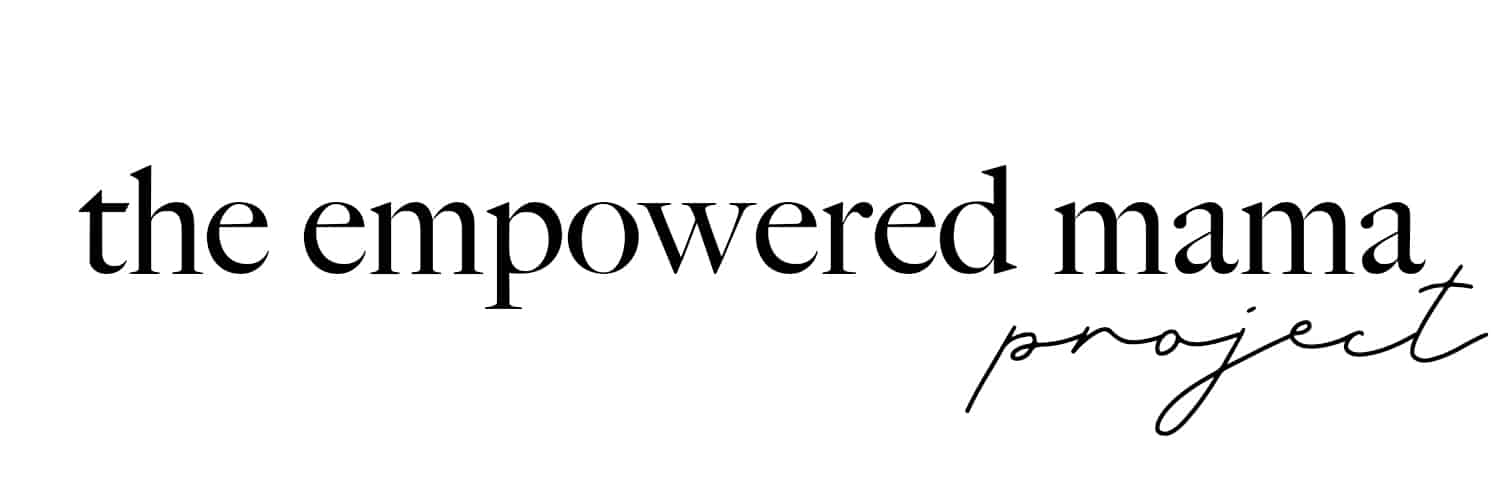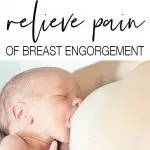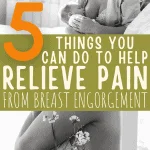For many women, breast tenderness is one of the first signs of pregnancy.
I found there was this nice little phase in my first pregnancy where my breasts knew I was pregnant and had started to increase in size, but my tummy had missed the memo and it was still flat without a bump.
It lasted about a week but man it was a good week.
What I wasn’t prepared for was the pain of breast engorgement that was going to hit me when my milk came in.
My son was in NICU and wasn’t allowed to feed, so I was hand expressing as I wasn’t allowed to use a pump until I had milk (another story for another day).
I remember I was having lunch one day and a friend went to hug me and I cried out in pain, my breasts were rock hard, had massive lumps in them and hurt so, so much.
If there’s one thing I can do well it is producing breastmilk. I have major oversupply at the start and was producing enough milk to feed an army of mini’s.
When I had my daughter, I was anticipating the breast engorgement, but due to her tongue and lip tie, I wasn’t able to relieve it by feeding her.
All of this meant that I had to learn really quickly how to relieve pain of breast engorgement, doing anything and everything I could to help reduce the pain and reduce the swelling.
This is what I found works well.
(If you have breast engorgement that won’t alleviate, this can quickly result in a serious medical condition called mastitis. Please seek help from a Lactation Consultant (IBCLC), a Midwife or a Doctor if you have breast engorgement and you cannot relieve it.)

1 – Feed Your Baby
If you can feed your baby, then this is the number one option.
Your baby is the best at extracting milk from your breasts, far better than a pump or than your hand and that milk is oh so good for them.
You may find that your baby has a little trouble latching if you are super engorged.
When there is a lot of pressure built up, it can make it difficult for babe to latch over your nipple as it can be hard and difficult to shape.
To help your babe, you can use a technique called ‘reverse pressure softening’.
This is a great article that explains how you can do it.
Essentially you are moving the milk from the areola back up into the breast area, in order to allow a softening, and allow your baby to latch.
2 – Warm Shower
I’ve heard many different ways of using warmth to help relieve pressure but have always found a warm shower to be best.
I’ve had the water as hot as I can stand it (which for me is fairly hot), and allowed the water to run over my front, back and shoulders.
Often this would result in some form of ‘leakage’ and milk would just run out of my breasts.
Initially, I was so terrified of letting any of my milk go to waste, but due to the extent of my engorgement, I had to do this in order to avoid mastitis.
You can also use some gentle massage of your breasts at this time to assist with flow and moving some of the milk out.
Other ways you can use warmth include warm compresses with clean cloths, heat packs (always applied over clothing, never directly to your skin) or warm bath.
The goal of applying warmth is to assist in moving your milk. It is important to remove the milk following the use of warmth, otherwise all you’re doing is triggering a let-down reflex and adding to the engorgement.
The best way to remove milk is to attach babe to the breast.
Babies are very good at taking off what they need and therefore tell your body how much milk to make… or not make.
If this is not an option, expressing by hand or pump may help.
If expressing, always remember the more you take off the more you signal your breasts to make. Don’t be too over-enthusiastic with expressing if you are experiencing engorgement.

3 – Cool Compress
Immediately after you’ve used the warming technique, and have removed some milk, you can apply a cool compress to help relieve swelling.
While the warm compress helps to move your milk, the cool compress immediately after acts in the reduction of swelling and therefore together they provide a great combination of relief.
There are many different methods I’ve heard women using from adding water to a nappy and popping it in the fridge, then wrapping it around your breast, to using cold cabbage leaves.
Personally, I soaked some small face washers in water and essential oils (check with your Lactation Consultant for which ones you can use and how) and then placed them in the freezer.
I would then wrap the frozen face washer around my breast (which was still warm from the hot shower) and sit it there until it was no longer cool.
4 – Pain Relief
The use of paracetamol (for pain relief) and ibuprofen (pain relief and anti-inflammatory) can help you feel more comfortable and help relieve the pain of breast engorgement.
These over the counter medications are considered generally safe for breastfeeding mothers, however, if you do have any concerns you can check with your Midwife for advice specific to you.
5 – Hand Express Excess
You may find that even after you’ve fed your baby you still feel engorged.
Your baby has quite a small stomach, which is why they feed for small amounts and feed frequently, however you may be producing more milk than your baby can consume.
If you’re finding you still feel engorged after feeding your babe, you can hand express and store your milk.
This is a great article on hand expressing and includes videos on how to do so effectively.
Hand expressing is much gentler than using a breast pump, which for some women can be too painful when they are engorged.
The idea isn’t to drain the breast completely, as that will just signal for your breast to make even more milk, which can be even worse for women who have oversupply.
You should express until you have relief from engorgement.

How To Prevent Breast Engorgement
It’s not uncommon for breast engorgement to occur when your milk first comes in.
It’s like the floodgates have been opened and your boobies are ready for business.
But breast engorgement can occur at any time. It can be incredibly painful, and if not treated properly can lead to serious medical conditions such as mastitis.
There are a few things you can do to prevent your chances of breast engorgement (and the pain that comes with it).
Most importantly, pay attention to your body, notice when your breasts are starting to feel full and act sooner rather than later.
1 – Feed On Demand
It is highly recommended by the World Health Organization and the American Academy of Paediatrics to breastfeed your baby on demand, that is following their feed cues and feeding them accordingly as opposed to scheduled feeding sessions.
This is even more important when wanting to prevent breast engorgement.
Your body responds to your baby and their needs.
Your baby’s stomach is very, very small when they are a newborn and therefore require more frequent feeds.
Breastmilk is also easily digested which means your baby may want to be fed more frequently.
Attempting to schedule feeds can result in breast engorgement, reduction in milk supply and can negatively affect your baby’s weight gain.
2 – Don’t Limit Feed Times
All babies are different.
Some feed super fast (my baby girl is like this) and some feed slow.
Some feeds can be 5 minutes and some can be an hour.
Breastfed babies don’t tend to overfeed and therefore will stop feeding at satiety.
If you limit their feed times you could be stopping their feed before they’ve had enough milk, and they may want to feed again soon after.
Furthermore, limiting feed times can contribute to foremilk-hindmilk imbalance.
However, for most women, the terms foremilk and hindmilk are something they can completely ignore.
Foremilk, which is typically what baby takes in earlier in the feed, is considered to have less fat content than hindmilk.
There is no disparity in nutrients and there is no rule of “the fattier the better”. Fat content of breastmilk naturally varies throughout a feed and throughout the day.
True foremilk-hindmilk imbalance usually only occurs when feeds are timed or when there is an oversupply.
Higher intake of the less fatty milk can cause gut irritability for babe.
Limiting feed times can also mean that your body is being triggered to make more milk (supply for demand) but not having each breast drained properly, leading to engorgement.
3 – Ensure Your Baby Has A Good Latch (See A Lactation Consultant IBCLC)
Breast engorgement can happen when your babe isn’t able to fully drain your breast, which can occur if your baby either doesn’t have a good latch or is unable to latch properly due to various reasons including tongue and lip tie.
Breastfeeding is a skill that both mum and baby need to learn, while we have natural instincts, there are still techniques that can make the difference between a difficult and painful breastfeeding experience and a relaxing and beautiful time.
I believe all Mamas should see a Lactation Consultant, but if you’re experiencing breast engorgement then you absolutely must see one.
When I had my baby girl, she had tongue and lip tie and difficulty latching.
Within 5 minutes of being with a Lactation Consultant she had diagnosed the ties and was able to help me get my baby girl to latch, something I had struggled with even as an experienced breastfeeding Mama.
A good latch means a good drain which means a happy baby and less chance of breast engorgement. Happy all around.
4 – Change Positions When Feeding Your Baby
Something as simple as changing the position your baby feeds can help drain different areas of your breast and allowing for further, full breast drainage.
Have a look at these various breastfeeding positions and try switching up your feeding styles to help prevent breast engorgement.
You may find starting in one position and moving to another mid feed will help your baby remove more milk from each breast.
You may also find gently massaging your breast while feeding can help move more milk and reduce the likelihood of breast engorgement.

5 -Pump Off Excess
If you have oversupply or find your baby is still not feeding quite as much as you’re producing, you can pump off excess milk until you’re comfortable.
As your baby gets older and starts to feed more, you’ll find you won’t need to do this as often, if at all.
However in the early days particularly, this can help you avoid engorgement and the pain that comes with it.
Be sure to only pump until you feel comfortable, rather than pumping for full drainage as your body will produce to demand if you’re pumping off more it will create more milk, which just adds to the engorgement issue.
Be sure to store this milk properly and you can use it at a later date.
Hopefully following these tips you’ll be able to relieve the pain of breast engorgement and avoid any more engorgement pain in the future.



















